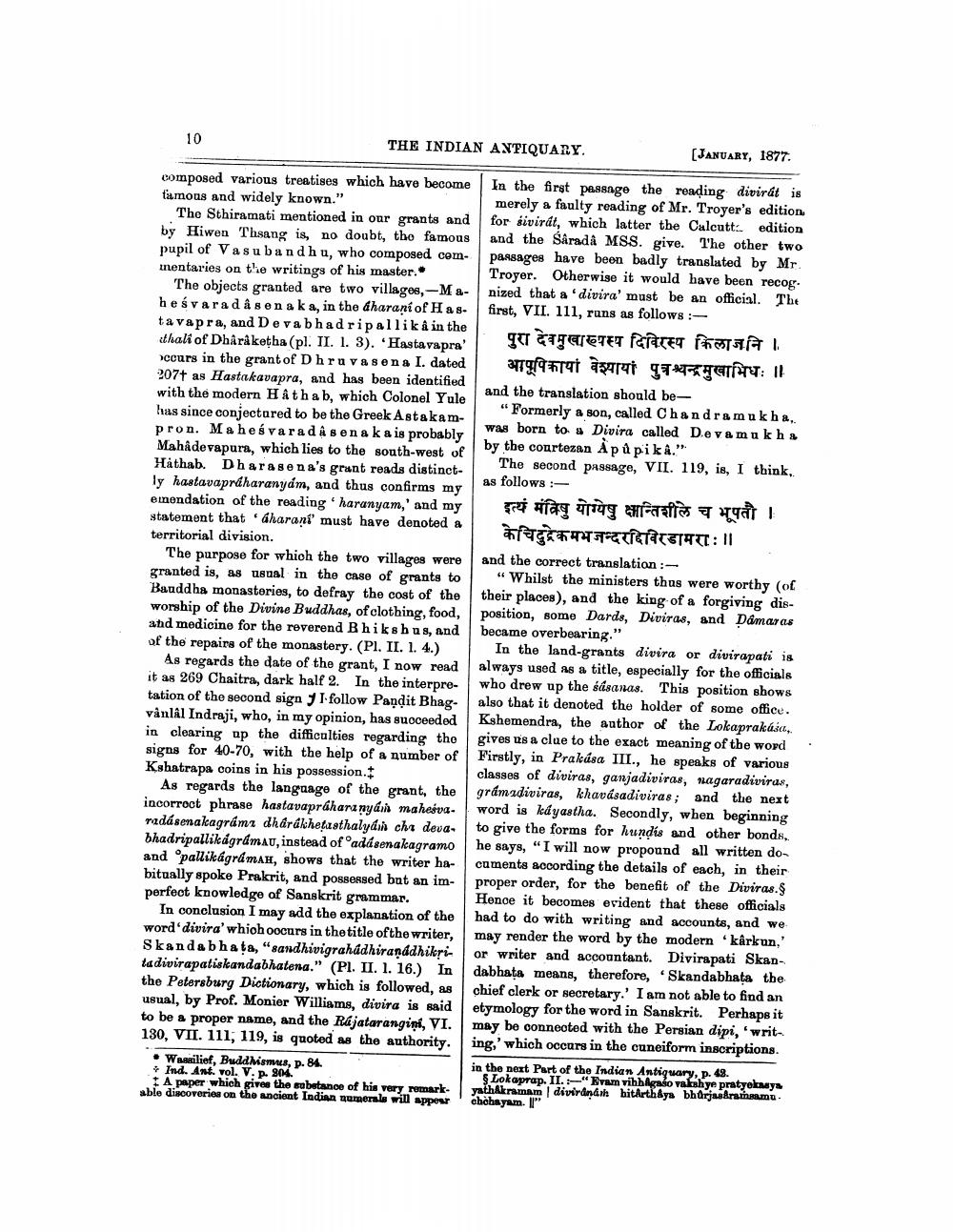________________
10
THE INDIAN ANTIQUARY.
(JANUARY, 1877.
composed various treatises which have become In the first passnge the reading divirát is famous and widely known."
merely a faulty reading of Mr. Troyer's edition The Sthiramati mentioned in our grants and for sivirát, which latter the Calcutt:. edition by Hiwen Thsang is, no doubt, the famous and the Sáradá MSS. give. The other two pupil of Vasu bandhu, who composed com- passages have been badly translated by Mr. mentaries on the writings of his master.
Troyer. Otherwise it would have been recog. The objects granted are two villages,-Ma- nized that a 'divira' must be an official. The heśvarad â sena ka, in the charani of Has. first, VII. 111, runs as follows :tavapra, and Devabhadripallik À in the
पुरा देवमुखाख्यस्य दिविरस्य किलाजनि । hali of Dhåråketha (pl. II. I. 3). Hastavapral cours in the grant of Dhruvasena I. dated आपूपिकायां वेश्यायां पुत्रश्चन्द्रमुखाभिधः ।। 2077 as Hastakavapra, and has been identified
and the translation should be with the modern Hátha b, which Colonel Yule
"Formerly a son, called Chandramukha.. has since conjectured to be the Greek Astakampron. Maheśvarada sena ka is probably
was born to Divira called Deva mukha Mahadevapura, which lies to the south-west of
by the courtezan Apů pika." Háthab. Dharasena's grant reads distinct
The second passage, VII. 119, is, I think, ly hastavapráharanyám, and thus confirms my
as follows: einondation of the reading haranyam,' and my | इत्यं मंविषु योग्येषु क्षान्तिशीले च भूपतौ । statement that áharani' must have denoted a
केचिदुद्रेकमभजन्दरदिविरडामराः॥ territorial division.
The purpose for which the two villages were and the correct translation:granted is, as usual in the case of grants to "Whilst the ministers thus were worthy (of Bauddha monasteries, to defray the cost of the their places), and the king of a forgiving disworship of the Divine Buddhas, of clothing, food, position, some Dards, Diviras, and Dâmaras and medicine for the reverend Bhikshus, and became overbearing." of the repairs of the monastery. (Pl. II. 1. 4.) In the land-grants divira or divirapati is
As regards the date of the grant, I now read always used as a title, especially for the officials it as 269 Chaitra, dark half 2. In the interpre- who drew up the sasanas. This position shows tation of the second sign follow Pandit Bhag- also that it denoted the holder of some office. vânlal Indraji, who, in my opinion, has succeeded Kshemendra, the author of the Lokaprakákot... in clearing up the difficulties regarding the gives us a clue to the exact meaning of the wovd signs for 40-70, with the help of a number of Firstly, in Prakása III., he speaks of various Kshatrapa coins in his possession. I
classes of diviras, ganjadiviras, nagaradivirus, As regards the language of the grant, the grámadiviras, khavásadiviras; and the next incorrect phrase hastavapraharanyain mahesva. word is kedyastha. Secondly, when beginning radásenakagrámı dhårákhetusthalydon chi deva, to give the forms for hundis and other bonds, bhadripallikágrámau, instead of adásenakagramo he says, “I will now propound all written do and pallikágrámah, shows that the writer ha- cuments according the details of each, in their bitually spoke Prakrit, and possessed bat an im- proper order, for the benefit of the Diviras. perfect knowledge of Sanskrit grammar. Honoe it becomes evident that these officials
In conclusion I may add the explanation of the had to do with writing and accounts, and we word divira'which oocurs in the title of the writer, may render the word by the modern 'kårkun,' Skanda bhata, "sandhivigrahadhiranddhikri- or writer and accountant. Divirapati Skanta divirapatiskandabhatena." (PI. II. 1. 16.) In dabhata means, therefore, Skandabhata the the Petersburg Dictionary, which is followed, as chief clerk or secretary.' I am not able to find an usual, by Prof. Monier Williams, divira is said etymology for the word in Sanskrit. Perhaps it to be a proper name, and the Rájatarangini, VI. may be connected with the Persian dipi, writ130, VII. 111, 119, is quoted as the authority. ing,' which occurs in the cuneiform inscriptions. • Wassiliof, Buddhismus, p. 84.
in the next Part of the Indian Antiquary, p. 43. Ind. Ant. vol. V. p. 804.
Lokaprap. II. -"Evam vibhagaso valoshye pratyelasy I A paper which gives the wobetance of his very remark- yathAkramam diviranah hitArthbya bhrjasAramamu. able discoveries on the ancient Indian numerals will appeurobohayam."




